When a Small Wish Comes True
2023.12.05 ~ 2024.08.18
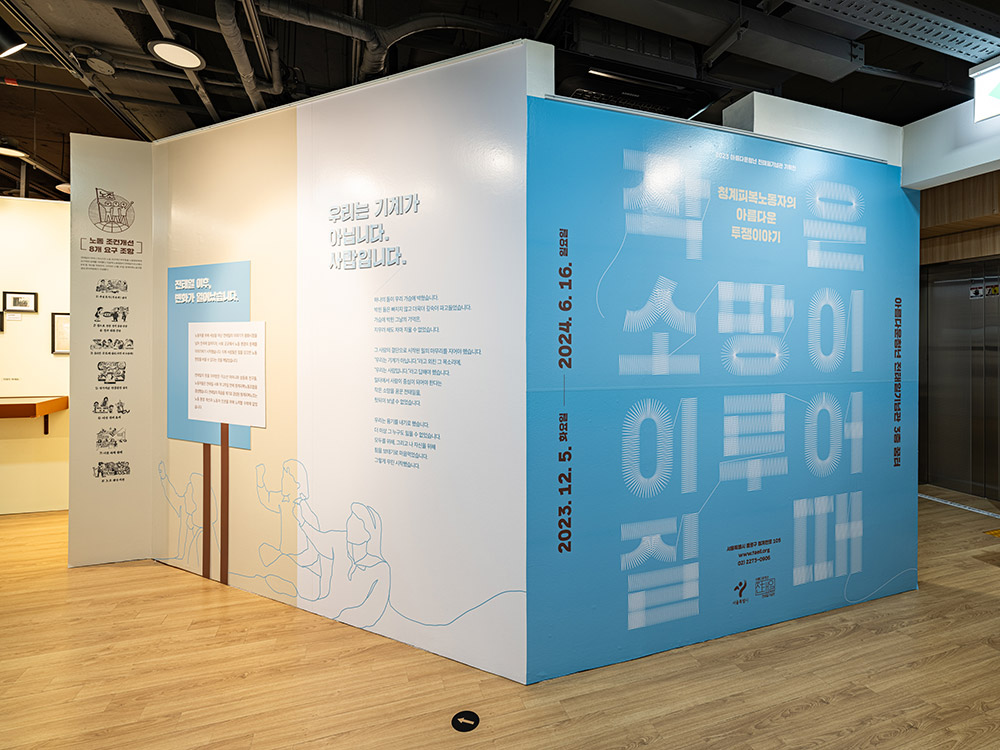
Prologue : We are not machines. We are human beings.
A stone is lodged in our hearts.
A stone that only bores deeper with time.
We cannot bear to erase
the memory of that day from our hearts.
We had to finish what he started.
To his cry, “We are not machines,”
our response could only be, “We are human beings.”
We could not let chun Tae-il’s small wish
to have workplaces centered around human beings
die in vain.
We chose to be brave.
We couldn’t lose anyone else.
For everyone and for ourselves,
we decided to join forces.
That’s how we began.
A stone is lodged in our hearts.
A stone that only bores deeper with time.
We cannot bear to erase
the memory of that day from our hearts.
We had to finish what he started.
To his cry, “We are not machines,”
our response could only be, “We are human beings.”
We could not let chun Tae-il’s small wish
to have workplaces centered around human beings
die in vain.
We chose to be brave.
We couldn’t lose anyone else.
For everyone and for ourselves,
we decided to join forces.
That’s how we began.
section 1. Organize
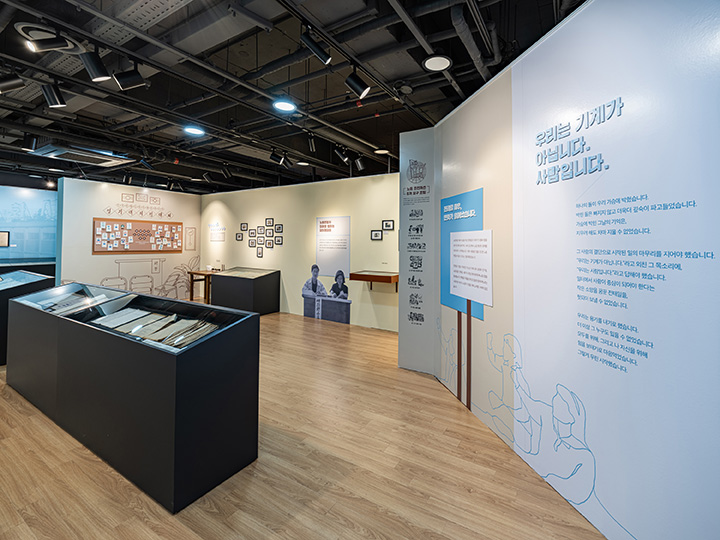
The Union Wasted No Time
On November 27, 1970, Lee So-seon and members of the Samdong Society formed the Cheonggye Garment Workers’ Union, which was officially called the Cheonggye Garment Workers’ Branch of the National Federation of Labor Unions. The Union wasted no time in preparing for discussions on equal terms with factory owners and held its first meeting with them on January 9, 1971. As a result, in only five months since its formation, the Union managed to start negotiating a collective agreement with garment manufacturers in four markets including Pyeonghwa Market, Tongil Shopping Mall, Donghwa Shopping Mall, and Dongsin Shopping Mall.
Representative Conventions Determined the Union’s Future
The Cheonggye Garment Workers’ Union elected representatives to discuss and decide matters on behalf of its members. Early on, the representative conventions focused on surveying working conditions, introducing a weekly holiday system, prohibiting night shifts, and resolving arrears. Such conventions show that the Union had been run democratically through its representatives.
On November 27, 1970, Lee So-seon and members of the Samdong Society formed the Cheonggye Garment Workers’ Union, which was officially called the Cheonggye Garment Workers’ Branch of the National Federation of Labor Unions. The Union wasted no time in preparing for discussions on equal terms with factory owners and held its first meeting with them on January 9, 1971. As a result, in only five months since its formation, the Union managed to start negotiating a collective agreement with garment manufacturers in four markets including Pyeonghwa Market, Tongil Shopping Mall, Donghwa Shopping Mall, and Dongsin Shopping Mall.
Representative Conventions Determined the Union’s Future
The Cheonggye Garment Workers’ Union elected representatives to discuss and decide matters on behalf of its members. Early on, the representative conventions focused on surveying working conditions, introducing a weekly holiday system, prohibiting night shifts, and resolving arrears. Such conventions show that the Union had been run democratically through its representatives.
section 2. Activity
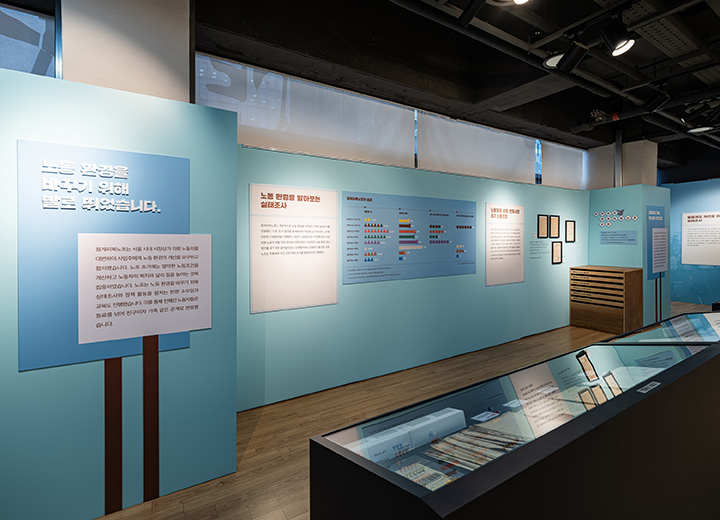
Surveys on Working Conditions
The Cheonggye Garment Workers’ Union conducted surveys to gain an objective grasp of the workplaces’ current situation. Its early surveys focused on compiling statistical data related to garment workers and the conditions they were working under at each factory. Such data was later used to draft proposals for the Union to present while negotiating a collective agreement with factory owners.
The Union Changed the Workers’ Lives
The Cheonggye Garment Workers’ Union sought to improve working conditions by identifying violations involving holidays and night shifts as well as resolving arrears, unpaid severance pay, or unfair dismissals. It conducted surveys on working conditions and used the results to propose ways to improve such conditions during its discussions with factory owners. The Union kept reminding its members and factory owners about the collective agreement that had been concluded and notified them of any violations.
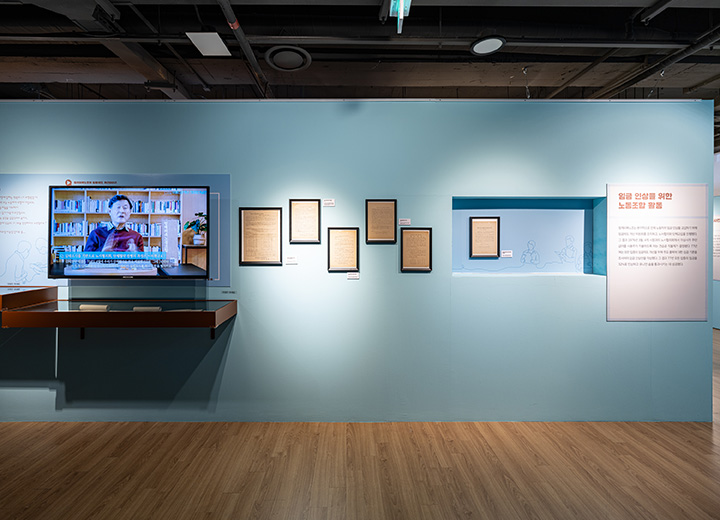
Surveys to Improve Wages
While the Korean economy experienced rapid growth in the early 1970s, workers’ wages remained unchanged despite the jump in prices. On January 31, 1974, the Cheonggye Garment Workers’ Union launched a task force for wage improvement and decided to conduct a survey ahead of its first wage negotiation. . The Union thus expanded its survey to all businesses in the industry between 1974 and 1975. Based on the expanded survey’s results, the Union decided to propose a 45 percent wage increase in May 1975.
Activities to Increase Wages
The task force the Cheonggye Garment Workers’ Union had launched for wage improvement began to engage in collective bargaining with factory owners. As a result, in March 1976, the factory owners from four different markets agreed to pay apprentices directly instead of paying them indirectly through sewing machine operators. In 1977, the Union surveyed the standard wages related to major items and proposed a wage increase for all occupations in the garment industry. It ultimately achieved a 32 percent rise in wages for all occupations and succeeded in introducing a union shop provision to the collective agreement.
The Cheonggye Garment Workers’ Union conducted surveys to gain an objective grasp of the workplaces’ current situation. Its early surveys focused on compiling statistical data related to garment workers and the conditions they were working under at each factory. Such data was later used to draft proposals for the Union to present while negotiating a collective agreement with factory owners.
The Union Changed the Workers’ Lives
The Cheonggye Garment Workers’ Union sought to improve working conditions by identifying violations involving holidays and night shifts as well as resolving arrears, unpaid severance pay, or unfair dismissals. It conducted surveys on working conditions and used the results to propose ways to improve such conditions during its discussions with factory owners. The Union kept reminding its members and factory owners about the collective agreement that had been concluded and notified them of any violations.

Surveys to Improve Wages
While the Korean economy experienced rapid growth in the early 1970s, workers’ wages remained unchanged despite the jump in prices. On January 31, 1974, the Cheonggye Garment Workers’ Union launched a task force for wage improvement and decided to conduct a survey ahead of its first wage negotiation. . The Union thus expanded its survey to all businesses in the industry between 1974 and 1975. Based on the expanded survey’s results, the Union decided to propose a 45 percent wage increase in May 1975.
Activities to Increase Wages
The task force the Cheonggye Garment Workers’ Union had launched for wage improvement began to engage in collective bargaining with factory owners. As a result, in March 1976, the factory owners from four different markets agreed to pay apprentices directly instead of paying them indirectly through sewing machine operators. In 1977, the Union surveyed the standard wages related to major items and proposed a wage increase for all occupations in the garment industry. It ultimately achieved a 32 percent rise in wages for all occupations and succeeded in introducing a union shop provision to the collective agreement.
section 3. Action
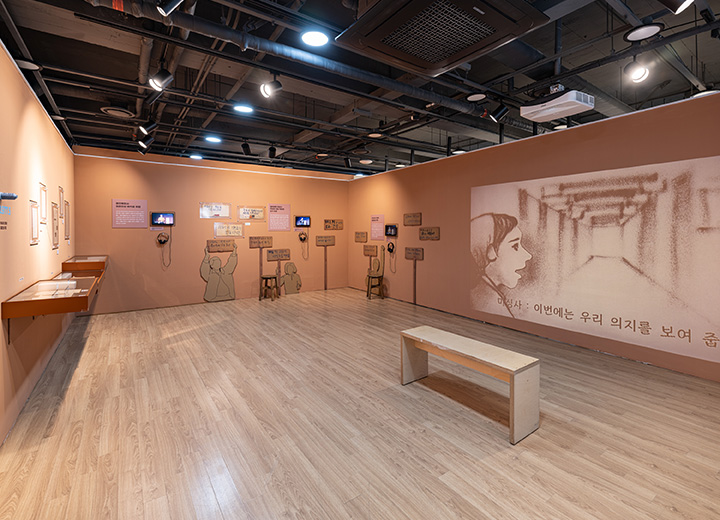
Solidarity Made Much Possible
In February 1975, the Union members joined forces to win back the right to run the Saemaul Lessons on Labor program. They eventually learned that by acting together, it was possible to change reality.
1975-77 Union Protests
Protest to Reclaim the Rights to Operate the Saemaul Lessons on Labor Program
Protest Against Gwangjin Apparel
Classroom Protest to Reduce Working Hours
Protest for Jacket Factories to Directly Pay Apprentices
The Samyang Corporation Incident
Yujin Industry’s Mass Dismissal
The Sinil Industries Incident
Protest Against Dress Shirt Makers
Protest Against Gwangjin Apparel
In 1975, ten sewing machine operators demanded that their employer Gwangjin Apparel raise their wage from 35 won to 40 won per dress shirt. The dress shirt maker’s sewing machine operators then began to chant slogans and sing in protest in front of their employer’s shop during lunch time. After a month of protesting, Gwangjin Apparel paid severance pay to the operators who were fired for demanding a raise.
Protest for Jacket Factories to Directly Pay Apprentices
The Cheonggye Garment Workers’ Union had created a task force to improve wages in jacket making. On March 6, 1976, two of the task force’s members named Im Geum-ja and Jeong Seon-hui launched a protest demanding jacket factories to directly pay their apprentices. Then some factories fired their workers for leading the protest, which prompted the Union members to plan a street demonstration in front of Pyeonghwa Market on March 26. Although the plan failed because of a leak, the authorities mediated the situation by having jacket factory owners agree to directly pay their apprentices.
Protest Against Dress Shirt Makers
On May 2, 1977, members of the Cheonggye Garment Workers’ Union who were working for Gwangjin Apparel, Darimsa, Samjeongsa, Angwangsa, and Yurimsa demanded a raise from 34 won to 50 won per dress shirt. A few days later on May 5, sewing machine operators stopped working and began to protest in the classroom originally meant for the Union’s educational programs.
In February 1975, the Union members joined forces to win back the right to run the Saemaul Lessons on Labor program. They eventually learned that by acting together, it was possible to change reality.
1975-77 Union Protests
Protest to Reclaim the Rights to Operate the Saemaul Lessons on Labor Program
Protest Against Gwangjin Apparel
Classroom Protest to Reduce Working Hours
Protest for Jacket Factories to Directly Pay Apprentices
The Samyang Corporation Incident
Yujin Industry’s Mass Dismissal
The Sinil Industries Incident
Protest Against Dress Shirt Makers
Protest Against Gwangjin Apparel
In 1975, ten sewing machine operators demanded that their employer Gwangjin Apparel raise their wage from 35 won to 40 won per dress shirt. The dress shirt maker’s sewing machine operators then began to chant slogans and sing in protest in front of their employer’s shop during lunch time. After a month of protesting, Gwangjin Apparel paid severance pay to the operators who were fired for demanding a raise.
Protest for Jacket Factories to Directly Pay Apprentices
The Cheonggye Garment Workers’ Union had created a task force to improve wages in jacket making. On March 6, 1976, two of the task force’s members named Im Geum-ja and Jeong Seon-hui launched a protest demanding jacket factories to directly pay their apprentices. Then some factories fired their workers for leading the protest, which prompted the Union members to plan a street demonstration in front of Pyeonghwa Market on March 26. Although the plan failed because of a leak, the authorities mediated the situation by having jacket factory owners agree to directly pay their apprentices.
Protest Against Dress Shirt Makers
On May 2, 1977, members of the Cheonggye Garment Workers’ Union who were working for Gwangjin Apparel, Darimsa, Samjeongsa, Angwangsa, and Yurimsa demanded a raise from 34 won to 50 won per dress shirt. A few days later on May 5, sewing machine operators stopped working and began to protest in the classroom originally meant for the Union’s educational programs.
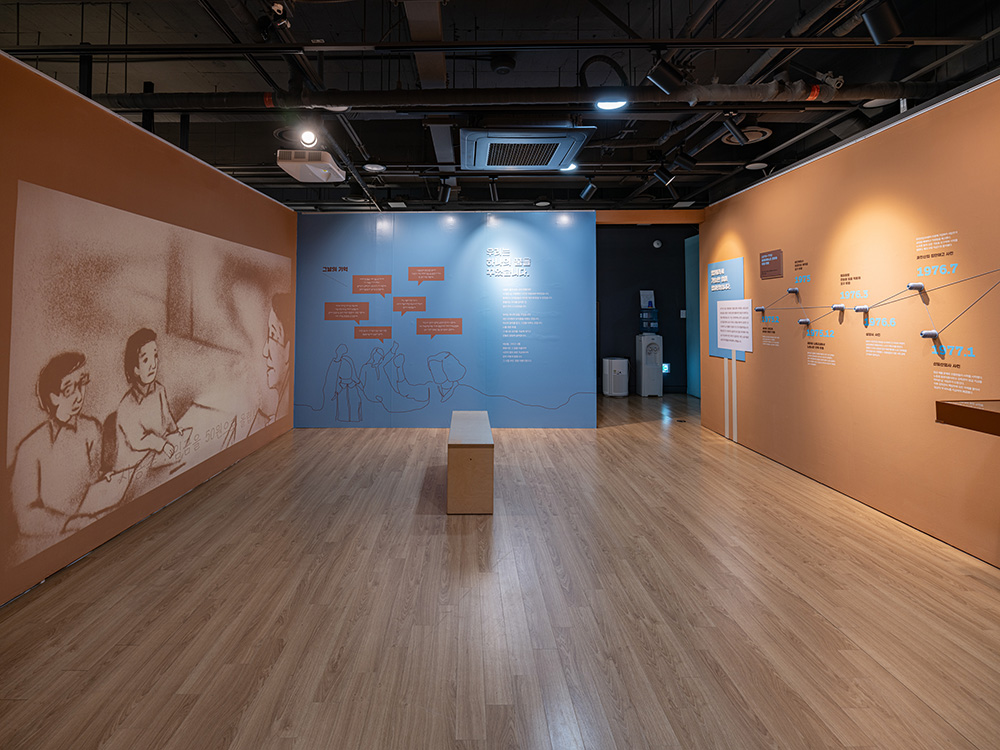
Epilogue : We had a dream
Although everything has changed over the years,
the fierce days of my youth
are ingrained in my heart.
Together, grains of sand were able to face giant waves.
It was we who hung on to our wavering selves.
We had a dream.
It was to reclaim our own name instead of Assistant No. 0.
It was to know our rights and own them.
Bearing in mind those glorious moments
when we fought for ourselves,
we get through another day.
Remembering the dream that changed
the world and myself,
I can now dare say
after all this time
that we were truly beautiful in those days.
Although everything has changed over the years,
the fierce days of my youth
are ingrained in my heart.
Together, grains of sand were able to face giant waves.
It was we who hung on to our wavering selves.
We had a dream.
It was to reclaim our own name instead of Assistant No. 0.
It was to know our rights and own them.
Bearing in mind those glorious moments
when we fought for ourselves,
we get through another day.
Remembering the dream that changed
the world and myself,
I can now dare say
after all this time
that we were truly beautiful in those days.

